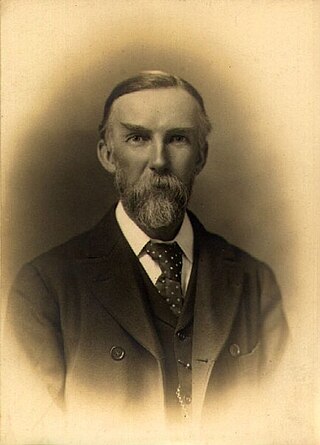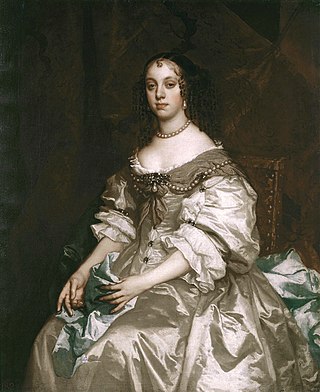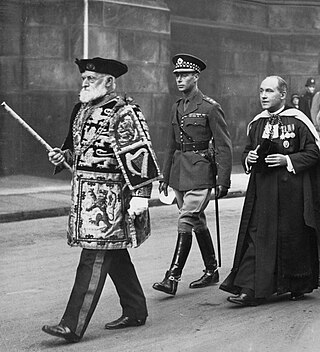Related Research Articles

The Dean Cemetery is a historically important Victorian cemetery north of the Dean Village, west of Edinburgh city centre, in Scotland. It lies between Queensferry Road and the Water of Leith, bounded on its east side by Dean Path and on its west by the Dean Gallery. A 20th-century extension lies detached from the main cemetery to the north of Ravelston Terrace. The main cemetery is accessible through the main gate on its east side, through a "grace and favour" access door from the grounds of Dean Gallery and from Ravelston Terrace. The modern extension is only accessible at the junction of Dean Path and Queensferry Road.
George Hill may refer to:

Sir John Robert Steell was a Scottish sculptor. He modelled many of the leading figures of Scottish history and culture, and is best known for a number of sculptures displayed in Edinburgh, including the statue of Sir Walter Scott at the base of the Scott Monument.

The Royal Scottish Academy (RSA) is the country’s national academy of art. It promotes contemporary Scottish art.

James Pittendrigh MacGillivray was a Scottish sculptor. He was also a keen artist, musician and poet. He was born in Inverurie, Aberdeenshire, the son of a sculptor, and studied under William Brodie and John Mossman. His works include public statues of Robert Burns in Irvine, Lord Byron in Aberdeen, the 3rd Marquess of Bute in Cardiff, John Knox in Edinburgh's St Giles Cathedral, and William Ewart Gladstone in Coates Crescent Gardens, Edinburgh.

Sir William Reid Dick, was a Scottish sculptor known for his innovative stylisation of form in his monument sculptures and simplicity in his portraits. He became an Associate of the Royal Academy in 1921, and a Royal Academician in 1928. Dick served as president of the Royal Society of British Sculptors from 1933 to 1938. He was knighted by King George V in 1935. He was Sculptor in Ordinary for Scotland to King George VI from 1938 to 1952 then held the post under Queen Elizabeth until his death in 1961.

Benno Schotz was an Estonian-born Scottish sculptor, and one of twentieth century Scotland's leading artists.
Physician to the King is a title held by physicians of the Medical Household of the Sovereign of the United Kingdom. Part of the Royal Household, the Medical Household includes physicians, who treat general conditions, and extra physicians, specialists who are brought in as required.
Gentleman Usher and Lady Usher are titles for some officers of the Royal Household of the United Kingdom. For a list of office-holders from the Restoration of the monarchy in 1660 up to the present day see List of Lady and Gentleman Ushers.

The Lord High Commissioner to the General Assembly of the Church of Scotland is the Scottish and later British monarch's personal representative to the General Assembly of the Church of Scotland, reflecting the Church's role as the national church of Scotland and the monarch's role as protector and member of that Church.
Alexander Carrick was a Scottish sculptor. He was one of Scotland's leading monumental sculptors of the early part of the 20th century. He was responsible for many architectural and ecclesiastical works as well as many war memorials executed in the period following World War I. As head of sculpture at Edinburgh College of Art, and as a leading member of the Royal Scottish Academy, Carrick had a lasting influence on Scottish sculpture.
Major Charles Murray Kennedy St Clair, 17th Lord Sinclair, CVO, DL was a Scottish peer who spent his entire life in the service of the Crown; as a soldier, an officer of arms, an equerry in the Queen Mother's Household, a representative peer and as a Lord Lieutenant.

Sir Alexander Blackie William Kennedy FRS, FRGS, better known simply as Alexander Kennedy, was a leading British civil and electrical engineer and academic. A member of many institutions and the recipient of three honorary doctorates, Kennedy was also an avid mountaineer and a keen amateur photographer being one of the first to document the archaeological site of Petra in Jordan following the collapse of the Ottoman Empire.

The Royal Households of the United Kingdom are the collective departments that support members of the British royal family. Many members of the royal family who undertake public duties have separate households. They vary considerably in size, from the large Royal Household that supports the sovereign to the household of the Prince and Princess of Wales, with fewer members.

The title of Principal Painter in Ordinary to the King or Queen of England or, later, Great Britain, was awarded to a number of artists, nearly all mainly portraitists. It was different from the role of Serjeant Painter, and similar to the earlier role of "King's Painter". Other painters, for example Nicholas Hilliard had similar roles with different titles. "Principal Painter in Ordinary", first used for Sir Anthony Van Dyck, became settled as the usual title with John Riley in 1689.

Reginald Francis Joseph Fairlie LLD was a Scottish architect. He served as a commissioner of RCAHMS and on the Ancient Monuments Board for Scotland.

Samuel Joseph was a British sculptor, working in the early 19th century.

Charles Laing Warr KCVO FRSE (1892–1969) was a Church of Scotland minister and author in the 20th century.

Patric Park was a Scottish sculptor.
References
- 1 2 The Laws of Scotland: Stair Memorial Encyclopaedia, Vol. 7 "The Crown", paragraph 848
- 1 2 3 4 5 6 "No ordinary sculptor". Scottish Government . 30 December 2008.